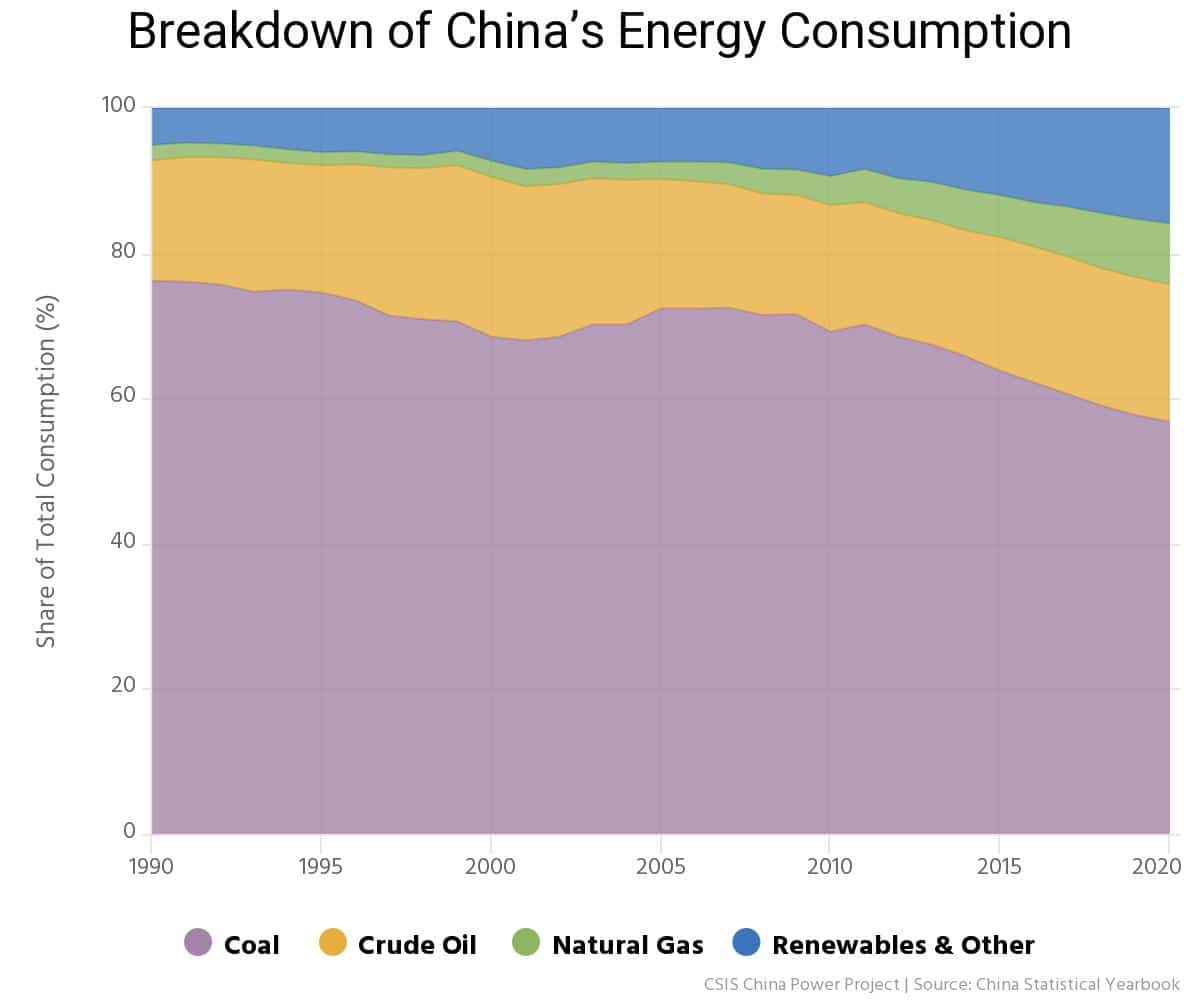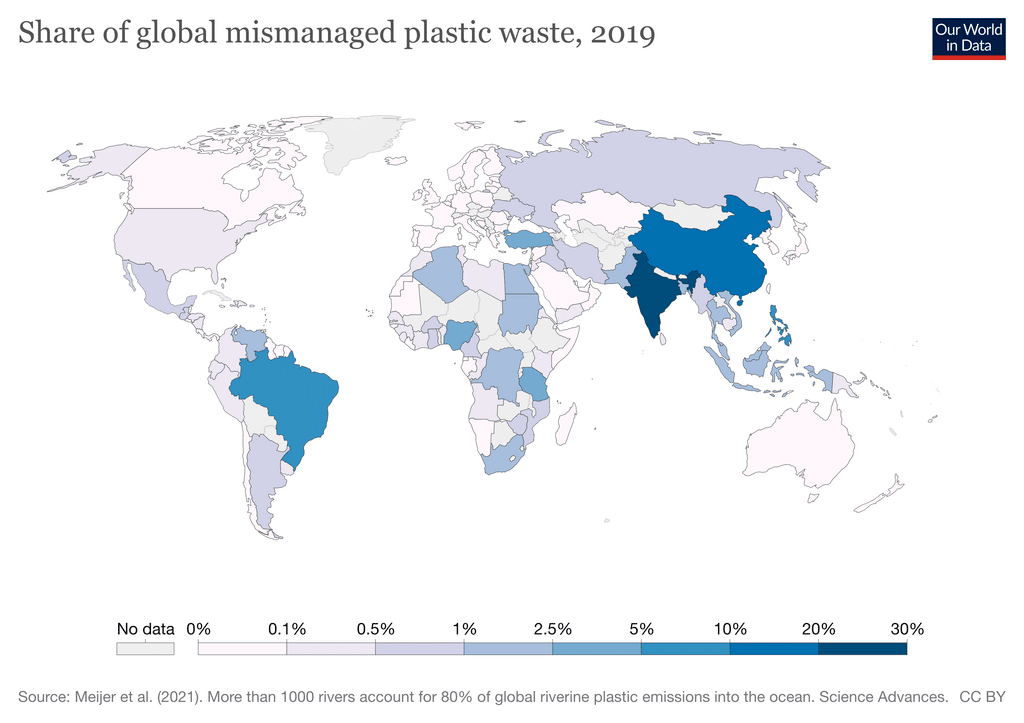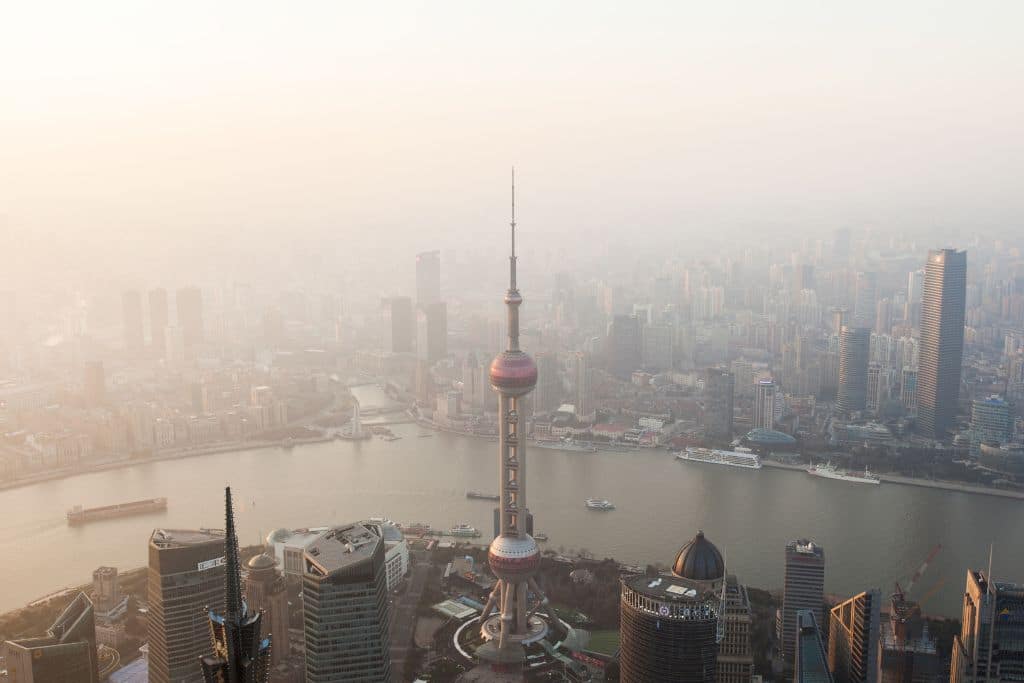The climate crisis is accelerating at a pace like never before. From deforestation and droughts to air and plastic pollution, these are just several factors that are exacerbating climate change and its consequences are felt everywhere in the world. China is certainly not spared by the effects of global warming and is experiencing more frequent natural disasters, which lead to destruction, great human suffering, and biodiversity loss. As of 2021, the economic superpower is ranked fourth in the world among countries with the most natural disasters worldwide. On track to becoming the world’s largest economy, China’s extremely rapid industrial expansion in recent decades has also contributed to record levels of air and water pollution. Here are five of the most worrisome environmental issues in China this year.
—
Top 5 Environmental Issues in China in 2024
1. Air Pollution
First on the list of environmental issues in China is air pollution. The country’s poor air quality is not exactly news. Since the beginning of its industrial expansion and economic boom in the late 1970s – which lifted 800 million people out of poverty and saw the country’s GDP grow at an average annual rate of 10% for four decades – the quality of air has progressively deteriorated.
According to the 2021 World Air Quality Report, out of 1,374 cities located in East Asia, 143 (or about 11%) recorded annual average PM2.5 concentrations that are seven times greater than World Health Organization (WHO) standards. All of them were located in China, with the town of Hotan in southwestern Xinjiang experiencing the highest level of pollution in the country at about 101 µg/m³, over 20 times the WHO guideline value.
Estimated to cause an average of 1.2 million premature deaths every year, China’s poor air quality is primarily attributed to the rapid economic expansion the country experienced since 1979, which resulted in a drastic increase in coal-powered industrial production and electricity demand, as well as an exponential rise in private vehicles. It is estimated that roughly 48% of Chinese CO2 emissions come from the industrial sector, with 40% from the power – mainly coal – and 8% from the transport industry. With an ever-increasing population, the demand for electricity has grown with no respite, leading to even more coal-burning and worsened air standards.
Furthermore, despite pledging to reach net zero emissions before 2060, the country remains by far the world’s largest producer and consumer of coal, which alone covers 60% of its electricity demand. In an effort to restore the economy to pre-pandemic levels and curb the energy crisis sparked by the exponential rise in industrial activities the country experienced in 2021, the Chinese government ordered factories to increase their production capacity and built more than triple the amount of new coal power capacity as the rest of the world combined. Unsurprisingly, CO2 emissions in the same year almost reached 12 billion tonnes, accounting for 33% of the global total.

Yet, despite the worrisome values recorded and no Chinese city meeting the WHO standards, air quality in China has consistently improved in recent years. Since 2018, major cities have seen an overall 21% reduction in annual PM2.5 concentrations, and in 2021, the capital city of Beijing met its own air pollution targets for the first time.
President Xi Jinping argues that fighting pollution is one of his top priorities, labelling this environmental issue as one of China’s ‘three tough battles’ – along with reducing poverty and improving financial stability. The long-term strategy focuses primarily on carbon emission intensity reduction through the primary use of non-fossil fuel energy. In recent years, China has placed a very strong emphasis on clean energy such as wind and solar. The latest Five-Year Plan (FYP) – one of the country’s most important policy blueprints – has set out a new strategy involving investment in onshore clean energy technologies, transmission grid, nuclear, as well as offshore wind in the coastal region.
With China being the world’s most populous nation, tackling the impending pressures of urbanisation – most notably air pollution – is especially crucial. To improve air quality in ever-expanding urban areas, the government is betting big on smart cities. Metropolises such as Beijing and Nanjing are already working on strategies to reduce pollution deriving from industries as well as traffic; they have adopted smart technologies to identify various pollutants, and develop green infrastructure powered by renewable energy sources.
You Might Also Like: Decarbonising Amid an Energy Crisis in China
2. Water Pollution
High on the list of environmental issues in China is water pollution. As much as 90% of the country’s groundwater is contaminated by toxic human and industrial waste dumping, as well as farm fertilisers, causing about 70% of rivers and lakes to be unsafe for human use. Nearly half of the population does not have access to water that is safe for human consumption, while two-thirds of the rural population has to rely on tainted water due to a lack of adequate systems to treat wastewater.
Based on this, it is clear that in China, the water you drink is as dangerous as the air you breathe. While air pollution can be observed by the naked eye, underground water pollution in cities is not as visible, causing it to be virtually forgotten and continue unabated. For decades, factories were able to discharge their wastewater into lakes and rivers across the country due to poor environmental regulations, weak enforcement, and the government’s failure to crack down on polluting industries. However, significant progress has been made in recent years.
The Thirteenth Five Year Plan (13FYP) in 2016 set specific goals for water consumption and water quality, aiming at reducing water consumption by 23% from 2015 levels by 2020. This includes upgrading urban sewage facilities, increasing rates of wastewater treatment, and forcing farmers to reduce the use of chemical fertilisers and insecticides in a bid to reduce contamination from agricultural pollutants. According to the 2020 State of Ecology & Environment Report, most of the key targets set in 13FYP have been met and exceeded, owing to the fact that within a very short period of time, the country managed to build more than 39,000 new sewage treatment facilities in 95% of municipalities and 30% of rural areas. To further improve water quality, the Chinese government funded the construction or renovation of nearly 80,000 kilometres of sewage collection pipeline network between 2021 and 2025.
Despite surface water continuing to improve, groundwater quality still has a long way to go, with just 13.6% considered fit for human consumption, according to the report. Water pollution still causes more than 100,000 deaths and economic losses of USD$1.5 trillion each year; this environmental issue is therefore something that China can no longer afford to ignore.
3. Food and Water Shortages
Besides pollution, water availability in China is also among the most worrisome environmental issues in China. It is exacerbated by the climate crisis, the effects of which considerably diminish the country’s accessible water resources, triggering severe shortages. Despite being home to almost 20% of the global population, China has only 6% of the world’s total freshwater resources.
In 2018, the total internal renewable water resources were estimated at 1,927 cubic metres per capita – nearly 75% less than the global average. To make matters worse, water is unevenly distributed across the country, with 80% concentrated in South China, despite the North being the core of national development. In the three heavily industrialised Northern provinces of Beijing, Tianjin, and Hebei – home to 130 million people – water available for human consumption is less than 184 cubic metres per person, well below the 500 cubic metre standard of water scarcity.

Scientific consensus says that climate change is playing a key role in the water shortage in China; increasing temperatures is one of the main factors exacerbating the crisis. On the one hand, glaciers in the Qinghai-Tibetan Plateau – also known as ‘The Third Pole’ – that have fed the Yangtze and Yellow Rivers with glacial meltwater for thousands of years, have retreated by 82% and more than one-fifth of the ice cover has disappeared since the 1950s. According to Greenpeace, the shortage will become ‘dramatically’ acute when these glaciers reach their ‘peak water’ – meaning that the rate of water consumption surpasses water supply – something that might happen as early as 2030.
On the other hand, rising temperatures have also impacted atmospheric circulation, making rainfall patterns unreliable and less frequent in northern and inland regions. Irregular rainfall has been the main culprit behind record-breaking droughts that have hit across the country in the last decade. Following an unprecedented 116-day drought occurring in the capital city between October 2017 and February 2018, China’s southern megacities Guangzhou and Shenzhen were faced with one of the most severe droughts in decades.
To tackle one of the most pressing environmental issues in China, the government developed several water schemes to boost water availability in dry regions. The most remarkable is the South-to-North Water Diversion Project. The plan is 50 years in the making, and involves infrastructure to divert nearly 45 billion cubic metres of water annually from the Yangtze River in the South to the dry north. While the USD$62 billion project is not expected to be fully completed before 2050, the East and Middle routes – opened respectively in 2013 and 2014 – are already transferring 20.9 billion cubic metres of water each year.
Unsurprisingly, these recurring droughts are also heavily impacting agriculture and compromising crops. A 2020 study investigating the impact of these weather events on Northeast China’s two main crops between 1961 and 2017 found that during moderate drought years, 3.2% of maize and 10.4% of soybean yields were lost. However, during more severe droughts recorded in recent years, losses reached 21.8% and 14% respectively.
Another huge issue affecting food security in China is desertification, a process by which natural and human causes reduce the biological productivity of drylands. Research shows that 27.4% of the country has undergone desertification, affecting about 400 million people. The entirety of China’s agricultural production comes from just 7% of its land area, most of which is located in northern areas that are severely affected by land degradation. This phenomenon threatens to leave much of these regions uninhabitable by degrading soil content, increasing rates of erosion, limiting natural vegetation, and almost entirely eliminating the possibility of agricultural production.
One of the government’s main strategies to combat desertification is the Great Green Wall of China, a project that involves the planting of around 88 million acres of forests stretching about 3,000 miles (4,828 kilometres) and as wide as 900 miles (1,448 kilometres). The results have so far been satisfactory: thousands of acres of moving dunes have been stabilised and the frequency of sandstorms nationwide fell by one-fifth between 2009 and 2014. However, some experts are more sceptical. Jennifer L. Turner – director of the China Environment Forum at DC-based Woodrow Wilson Center – says, “with the Great Green Wall, people are planting lots of trees in big ceremonies to stem desertification, but then later no one really takes care of them and they die.”
You Might Also Like: Tackling China’s Water Shortage Crisis
4. Plastic Pollution
Plastic pollution is not surprisingly also among the most pressing environmental issues in China. This problem has long plagued China largely thanks to the fact that the country is the world’s largest producer and consumer of plastics.
Home to one-third of the world’s single-use plastic production facilities, in 2020 alone China produced about 60 million tonnes of plastic waste. However, on average, only about 17% is recycled in some shape or form. Moreover, along with India and Brazil, the economic superpower holds around 20% of the global share of mismanaged plastic waste, which not only contributes to increased methane emissions from landfills, but eventually makes its way into the ocean via inland waterways or through wind and tides. The Yangtze river – Asia’s longest and the world’s third-longest river – has turned into one of the biggest sources of global plastic pollution. This is an extremely worrying issue that the government cannot afford to ignore, given the fact that its basin comprises one-fifth of the country’s land area and supports and houses nearly one-third of the population.

Not only does China produce immense quantities of plastics each year, but it also consumes at least one-fifth of the world’s plastics and up until recently, it was also the largest importer of plastic, acting as the dumping ground for nearly 600,000 metric tons of trash from foreign nations each year. The rapidly growing amount of plastics the country had to deal with prompted the government to introduce an import ban on solid waste including several types of plastics and other recyclable waste, which came into effect on January 1, 2018. Within just a few months, the decision halved imports of solid waste and nearly ceased imports of scrap plastic.
In 2021, China also launched its fourteenth five-year action plan to facilitate the phase-out of manufacturing and circulation of single-use plastics – which are almost entirely made from fossil fuels – while promoting alternatives and boosting recycling. The government introduced several new policies targeting plastic shopping bags and the use of disposable plastics in restaurants. Waste incineration capabilities are also to be greatly increased, with the aim of reaching up to burning 800,000 tons of urban domestic waste per day by 2025. Aware of its rapidly growing e-commerce industries, the government is pushing all retail, e-commerce, and express parcel delivery businesses to slash the ‘unreasonable’ use of disposable plastic packaging by 2025, and to have at least 10 million reusable boxes for express delivery in use.
You Might Also Like: What Are the Consequences of China’s Import Ban on Global Plastic Waste?
5. Biodiversity Loss
Last on our list of environmental issues in China is biodiversity loss. As a consequence of nature degradation and increased pollution from human activities, the country is threatening the survival of thousands of animal and plant species.
According to the International Union for Conservation of Nature (IUCN) Red List, 1,078 known species in China are currently categorised as critically endangered, endangered, or vulnerable, placing the economic superpower among the countries with the most threatened species in the world. Moreover, a WWF report reveals that since 1970, half of China’s terrestrial vertebrates have vanished, while simultaneously, the nation’s ecological footprint has more than doubled.
Water pollution in particular is affecting vital resources and threatening thousands of species whose survival depends on river and ocean water. The Yangtze river, one of China’s most crucial water bodies, is also the world’s largest source of ocean plastic and a vector for more than half of all marine plastic pollution – disgorging hundreds of thousands of tonnes annually. Fish makes up the majority of diets for many people in China. As a result of ocean plastic pollution – where plastics slowly break down into smaller debris and particles called microplastics – one study discovered that all 21 species of sea fish and freshwater fish from Chinese waters that were examined have ingested plastic. This means that people eating fish have also been consuming plastics.
Ironically, some of the country’s strategies to tackle the most pressing environmental issues are hurting biodiversity. The most striking example is the aforementioned North-to-South Water Diversion Project, China’s best strategy to solve the water shortage crisis. As construction advances across the country, natural landscapes are harmed, leading to biodiversity loss, since all three routes will change natural hydrology on an unprecedentedly large scale; the East Route, for example, raises the water level of the four lakes it passes through. A 2019 study estimated that aquatic plants will decline by up to 0.25 million tons in Dongping Lake surrounding the construction of the East Route and freshwater clams, whitebaits and algae are among the species that will be most affected by this.
This is not the first time that China’s water schemes have led to the disappearance of local species. In the last decade, the construction of the Three Gorges Dam has permanently changed the Yangtze’s landscape, damaging the habitat of the already-endangered baiji dolphin and rendering them ‘functionally extinct’ at the end of 2006.
If you liked reading about some of the biggest environmental issues in China, you might also like: 6 Biggest Environmental Issues in Hong Kong
This story is funded by readers like you
Our non-profit newsroom provides climate coverage free of charge and advertising. Your one-off or monthly donations play a crucial role in supporting our operations, expanding our reach, and maintaining our editorial independence.
About EO | Mission Statement | Impact & Reach | Write for us


















